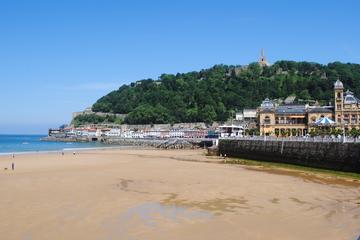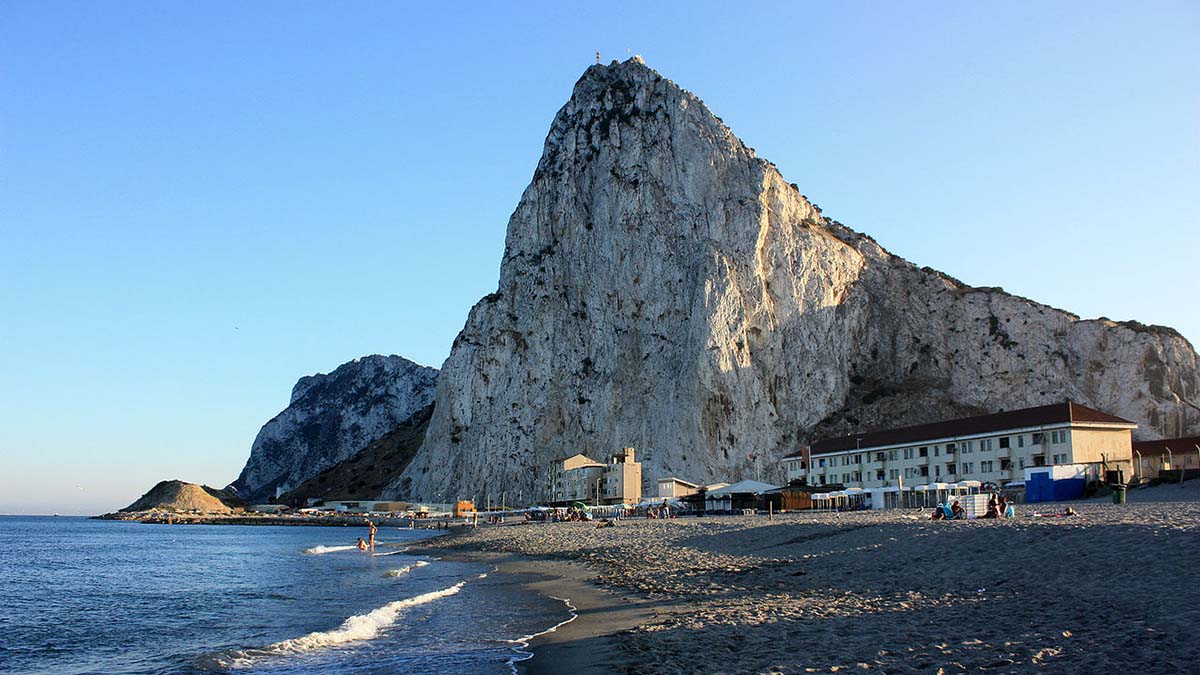
by Matthew Adams
I arrived in Gibraltar aboard the Crown Princess Grand-class cruise ship. It was returning from Corsica back to Britain. Gibraltar, a U.K. overseas territory on the south coast of Spain, was the final stop on the way back. On a sunny morning in May, I disembarked from the ship along the Western Arm in northern Gibraltar.
 Then the Rock of Gibraltar, in all its glory, came into view. The Rock rises some 426 meters above the sea. As such, it’s almost a small mountain! Even though it’s a limestone rock, the Rock of Gibraltar is very green. The Rock has lots of vegetation and an abundance of wildlife. On its higher levels there is the Upper Rock Nature Reserve, which includes various migrating birds and the famed Gibraltar Barbary macaques.
Then the Rock of Gibraltar, in all its glory, came into view. The Rock rises some 426 meters above the sea. As such, it’s almost a small mountain! Even though it’s a limestone rock, the Rock of Gibraltar is very green. The Rock has lots of vegetation and an abundance of wildlife. On its higher levels there is the Upper Rock Nature Reserve, which includes various migrating birds and the famed Gibraltar Barbary macaques.
After disembarking from the ship, I strolled through a cruise terminal building en route to the North Mole. Within the terminal building there was a sculpture of the magnificent rock. Thereafter, I arrived at the North Mole where a line of taxi vans had parked. As the taxis were providing short tours I boarded one as an alternative to climbing the Rock via the cable cars which link to the Signal Hill near its summit. They rise some 387 meters to the Water Catchment Area which provides various vantage points from the Rock.
Soon after getting in the taxi, it began the ascent up the Rock after passing through Gibraltar. The taxi van clambered up the somewhat narrow Rock of Gibraltar lanes. It stopped at the Pillar of Hercules. That’s a monument that flanks the Strait of Gibraltar which is the gateway to the Mediterranean.
St. Michael’s Cave
After a brief stop the taxi continued the climb up the Rock of Gibraltar. The next stop was St Michael’s Cave. These are a network of limestone caves located in the Upper Rock Nature Reserve.
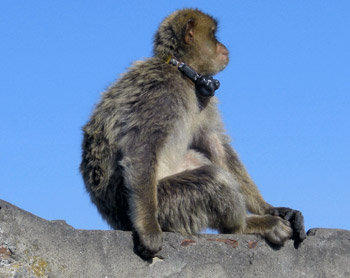 When the taxi stopped, I was some 300 meters above sea level. Upon vacating the taxi, a few of the Rock’s Barbary macaques surrounded the entrance to the cave. Gibraltar is the only destination in Europe where you will find any Barbary macaques.
When the taxi stopped, I was some 300 meters above sea level. Upon vacating the taxi, a few of the Rock’s Barbary macaques surrounded the entrance to the cave. Gibraltar is the only destination in Europe where you will find any Barbary macaques.
I went inside St Michael’s Cave. It’s a very finely preserved, and colourfully lit, cave with plenty of stalactites hanging from the ceiling. After entering I strolled down to the cave’s auditorium stage. With a number of plastic chairs at the higher level of the chamber this cave has been a venue for various concerts.
After leaving the cave, I returned to the taxi. We continued up the Rock and stopped somewhere close to the summit. I was probably some 350 – 400 meters up. When close to the summit of the Rock the coast of Africa is visible on a clear day.
The Great Siege Tunnels
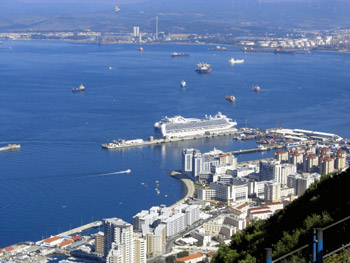 The tour continued towards the northern side of the Rock. It was there that we reached the Great Siege Tunnels which I briefly walked through. Their entrances are located at a point of the rock that overlooks Gibraltar’s airstrip close to the border.
The tour continued towards the northern side of the Rock. It was there that we reached the Great Siege Tunnels which I briefly walked through. Their entrances are located at a point of the rock that overlooks Gibraltar’s airstrip close to the border.
Given Gibraltar’s position as the gateway to the Mediterranean it was a notable strategic outpost of the British Empire, and today a Royal Navy base is still located there. As such, the British dug a network of military tunnels through the Rock during the Great Siege of Gibraltar to ensure that it remained a part of their empire. The tunnels provided cover for Gibraltar’s defenders from both naval and air bombardments. The Spanish and French never did take it, and today you can go inside the tunnels which include small windows and artillery pieces.
Grand Casemates Square
The tunnels were the last stopping point of the tour before the taxi left the Rock. We bypassed the Moorish Castle located along the north-west of the Rock. The taxi returned to Grand Casemates Square, the largest of two main squares within the city centre of Gibraltar. This square is at the northern end of Gibraltar’s Main Street. At the northern end of the square there is a bomb-proof barracks.
Here you may as well be back in England. Gibraltar is, after all, U.K. territory. Consequently, there is no requirement for Euros; and all of Gibraltar is in English! Pubs align the square which is a gateway to Gibraltar’s town centre. Further down the Main Street you can find NatWest and Barclay branches, and at the end you can board the cable cars located beside La Alameda Gardens. Those are six hectare botanical gardens.
When at the square I stopped off at the Gibraltar Glass Museum. It is here that a variety of glass is crafted by glass blowing. In the museum glass blowers craft the glass for visitors. There are also plenty of glass Rock of Gibraltars included at the museum.

 Gibraltar Beaches
Gibraltar Beaches
Although I never found them, Gibraltar also has a few beaches along its coastline. Not far off the North Front Airfield there is the Eastern Beach. Further south there are the sandy Governor’s Beach and Windhill Beach. In total there are six beaches along its eastern coastline, of which the Eastern Beach is the longest.
After a stroll down the Main Street, I returned to the ferry terminal to board the ship. The climb up the Rock of Gibraltar had provided some dazzling views of the Bay of Gibraltar and beyond. If visiting Spain this is one destination not to miss.
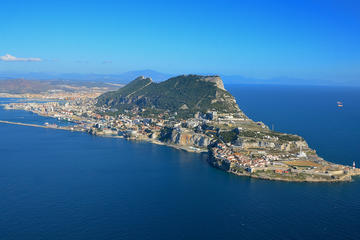
Full-day Gibraltar Tour from Seville with Rock of Gibraltar, St. Michael´s Cave
If You Go:
♦ Gibraltar Beaches
♦ Visit Gibraltar
♦ Info Centre
♦ La Alameda Gardens
♦ St Michael’s Cave
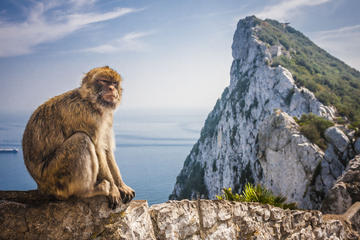
Gibraltar and Vejer Private Day Trip from Málaga
Photo credits:
Top Gibraltar Eastern Beach by Gibmetal77 / CC BY-SA
All other photos by Matthew Adams:
The summit of the Rock of Gibraltar
A Barbary macaque
The Crown Prince cruise ship
About the author:
Matthew Adams is a freelancer that has produced a variety of articles for various publications and websites such as Swing Golf Magazine,TripAdvisor, Captured Snapshot, Coed Magazine the Washington Post and Vagabundo Travel. Matthew also has his own golf blog at: amateurgolfer.blogspot.co.uk/.

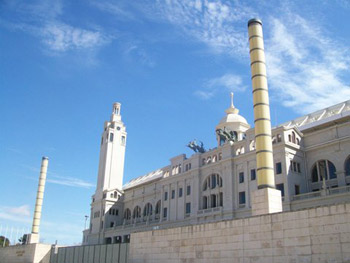
 I settled in on the first two days, and on Saturday visited Montjuic Park for the marathon expo; to collect my race number and timing chip. The Museum of Arts towers over the front of the park; above cascading fountains framed by rows of steps. Musicians and giant dolls entertained in the square at the bottom of the cascading fountain.
I settled in on the first two days, and on Saturday visited Montjuic Park for the marathon expo; to collect my race number and timing chip. The Museum of Arts towers over the front of the park; above cascading fountains framed by rows of steps. Musicians and giant dolls entertained in the square at the bottom of the cascading fountain.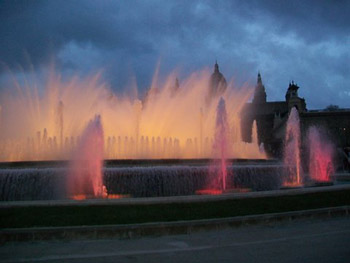 I returned in the night to watch the Magic Fountain show. Every fifteen minutes between 7pm and 9pm the circular fountain at the foot of the hill seems to be awakened by music, spraying water high in the air while changing colours.
I returned in the night to watch the Magic Fountain show. Every fifteen minutes between 7pm and 9pm the circular fountain at the foot of the hill seems to be awakened by music, spraying water high in the air while changing colours.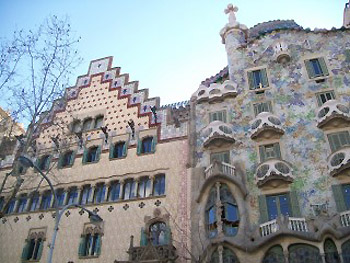 After about four miles the circuit took us past Camp Nou; the 98,000-capacity home of FC Barcelona is the largest stadium in Europe. That night I joined 68,000 people at the stadium to watch Barcelona beat Rayo Vallecano 3-1. Climbing to a seat about five rows from the top of the 150-feet-high stadium was hard work, but worth it, with the sensation of emerging into the steep-sided seating above the bright green pitch reminding me of the Lost Horizon story of a Shangri-La hidden in the Himalayan mountains.
After about four miles the circuit took us past Camp Nou; the 98,000-capacity home of FC Barcelona is the largest stadium in Europe. That night I joined 68,000 people at the stadium to watch Barcelona beat Rayo Vallecano 3-1. Climbing to a seat about five rows from the top of the 150-feet-high stadium was hard work, but worth it, with the sensation of emerging into the steep-sided seating above the bright green pitch reminding me of the Lost Horizon story of a Shangri-La hidden in the Himalayan mountains.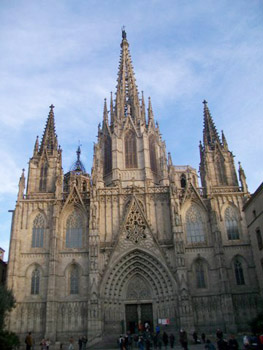 Antoni Gaudi was Modernisme’s most famous artist, and a couple of miles later we passed the movement’s crowning glory. La Sagrada Familia is still under construction a century later. The 13,000-capacity cathedral’s size distinguished it from other cathedrals while passing, and on closer inspection so does its blending of nature into the design. Gaudi liked curves rather than straight lines, claiming there were none of the latter in nature; and some spire-tops are decorated with balls of fruit-colours.
Antoni Gaudi was Modernisme’s most famous artist, and a couple of miles later we passed the movement’s crowning glory. La Sagrada Familia is still under construction a century later. The 13,000-capacity cathedral’s size distinguished it from other cathedrals while passing, and on closer inspection so does its blending of nature into the design. Gaudi liked curves rather than straight lines, claiming there were none of the latter in nature; and some spire-tops are decorated with balls of fruit-colours.
 The sky cleared the next day, and temperatures rose into the 60s Fahrenheit. I took the train out to Monistrol de Montserrat, and hiked to the Santa Maria de Montserrat monastery. To the north-west, snow-capped Pyrenees signified the border with France, while the Mediterranean Sea was visible to the east.
The sky cleared the next day, and temperatures rose into the 60s Fahrenheit. I took the train out to Monistrol de Montserrat, and hiked to the Santa Maria de Montserrat monastery. To the north-west, snow-capped Pyrenees signified the border with France, while the Mediterranean Sea was visible to the east.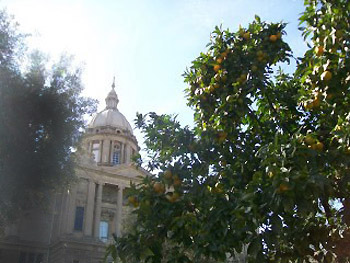 The next day I returned to Montjuic Park, going past the Arts Museum to the Olympic Stadium, which brought back memories of the 1992 Games. I walked past torch-pillars and the Telefonica tower to the tree-filled green zone leading up to Barcelona’s castle. Cannons point up and down the coast and there are great views of the city all the way to Tibidabo Mountain, overlooking Barcelona on the western horizon. The castle has a chequered past, being used to hold and execute prisoners in the civil war and other twentieth-century conflicts.
The next day I returned to Montjuic Park, going past the Arts Museum to the Olympic Stadium, which brought back memories of the 1992 Games. I walked past torch-pillars and the Telefonica tower to the tree-filled green zone leading up to Barcelona’s castle. Cannons point up and down the coast and there are great views of the city all the way to Tibidabo Mountain, overlooking Barcelona on the western horizon. The castle has a chequered past, being used to hold and execute prisoners in the civil war and other twentieth-century conflicts.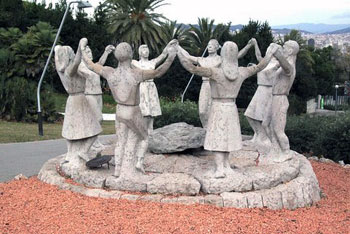

 I had read in a guidebook that on Sundays at noon local Barcelonians gather together to dance the Sardana in the square by the Barcelona Cathedral in the Gothic Quarter where my hotel was conveniently located. The Sardana was on my “to-see” list, but I only had one Sunday in Barcelona and I wanted to spend the day hanging out in Gaudi’s “must-see” Parc Guell on the other side of town.
I had read in a guidebook that on Sundays at noon local Barcelonians gather together to dance the Sardana in the square by the Barcelona Cathedral in the Gothic Quarter where my hotel was conveniently located. The Sardana was on my “to-see” list, but I only had one Sunday in Barcelona and I wanted to spend the day hanging out in Gaudi’s “must-see” Parc Guell on the other side of town. When I wasn’t watching the dancers’ feet in exasperation, I found myself alternately intrigued by an elderly man in one of the larger circles and two young couples who had formed their own circle on the periphery.
When I wasn’t watching the dancers’ feet in exasperation, I found myself alternately intrigued by an elderly man in one of the larger circles and two young couples who had formed their own circle on the periphery. While tourists streamed in and out, I stayed for the entire performance that lasted almost two hours. At one point a Sardanista, who “worked the crowd” to solicit donations for the local Sardana organization, accidentally hit me in the back with her foot. I was fine, but profusely apologetic, she kept coming back to me every fifteen minutes to assure herself that I was okay. After the performance she told me, through her French-speaking friend (I know some French), that I must return the following day (Sunday) at noon for the next Sardana performance.
While tourists streamed in and out, I stayed for the entire performance that lasted almost two hours. At one point a Sardanista, who “worked the crowd” to solicit donations for the local Sardana organization, accidentally hit me in the back with her foot. I was fine, but profusely apologetic, she kept coming back to me every fifteen minutes to assure herself that I was okay. After the performance she told me, through her French-speaking friend (I know some French), that I must return the following day (Sunday) at noon for the next Sardana performance.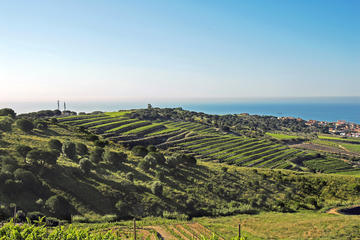
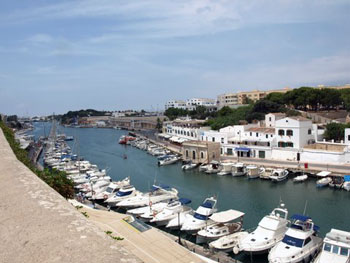
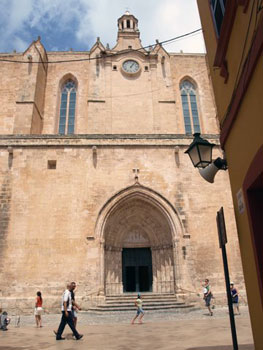 The 14th century Cathay Gothic cathedral in the Plaza de Pio XII, and its surrounding area, miraculously escaped destruction in 1558 when Barbarossa, the pirate Red Beard, attacked and destroyed the town with his Turkish mercenaries. The cathedral’s ornate Baroque style Chapel of the Souls was added in the 17th century, when much of the town was finally rebuilt. Then in the 19th century, it was finished with a neo-classical front facade. It still also contains a small minaret from the mosque that occupied its space before it was turned into a cathedral on the orders of King Alfonso III of Aragón, who took the island from its ruling Moors in 1287.
The 14th century Cathay Gothic cathedral in the Plaza de Pio XII, and its surrounding area, miraculously escaped destruction in 1558 when Barbarossa, the pirate Red Beard, attacked and destroyed the town with his Turkish mercenaries. The cathedral’s ornate Baroque style Chapel of the Souls was added in the 17th century, when much of the town was finally rebuilt. Then in the 19th century, it was finished with a neo-classical front facade. It still also contains a small minaret from the mosque that occupied its space before it was turned into a cathedral on the orders of King Alfonso III of Aragón, who took the island from its ruling Moors in 1287.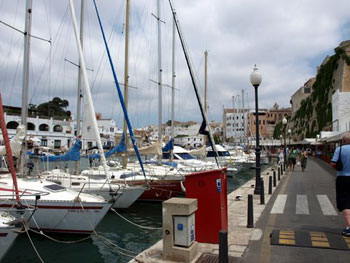 The square is edged with grand palaces on the cathedral side opposite the imposing Town Hall and theatre. Next to the theatre is a magnificent viewpoint looking out over the harbour. A couple of pavement cafes sit beyond this next to the corner that leads to the steps down to the harbour, which is lined on this side with popular restaurants.
The square is edged with grand palaces on the cathedral side opposite the imposing Town Hall and theatre. Next to the theatre is a magnificent viewpoint looking out over the harbour. A couple of pavement cafes sit beyond this next to the corner that leads to the steps down to the harbour, which is lined on this side with popular restaurants.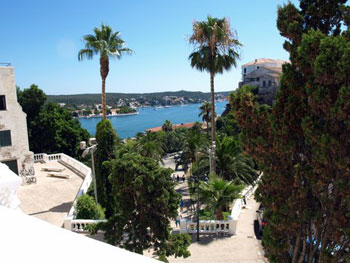 The natural advantages of the waters of Mahon meant that the British based themselves there and declared it the new capital of the island. But the clerics of the time refused to move, so Ciutadella retains its cathedral and its religious superiority.
The natural advantages of the waters of Mahon meant that the British based themselves there and declared it the new capital of the island. But the clerics of the time refused to move, so Ciutadella retains its cathedral and its religious superiority. Unlike Ciutadella, Mahon town occupies only the southern side of the port. The opposite side houses the naval base. It is also where new resorts are being developed alongside some wonderful villas that include one where Admiral Nelson and Emma Hamilton are said to have had some romantic trysts.
Unlike Ciutadella, Mahon town occupies only the southern side of the port. The opposite side houses the naval base. It is also where new resorts are being developed alongside some wonderful villas that include one where Admiral Nelson and Emma Hamilton are said to have had some romantic trysts.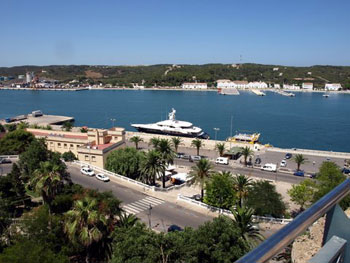 Back on the harbour side of Mahon, if it’s time for a tipple, you can head for the centuries old Xoriguer Gin Distillery, famous for supplying unique Menorcan gin to Admiral Nelson’s British sailors. Or there are plenty of good bars and restaurants on the landward side of the harbour road, or up in the town above.
Back on the harbour side of Mahon, if it’s time for a tipple, you can head for the centuries old Xoriguer Gin Distillery, famous for supplying unique Menorcan gin to Admiral Nelson’s British sailors. Or there are plenty of good bars and restaurants on the landward side of the harbour road, or up in the town above.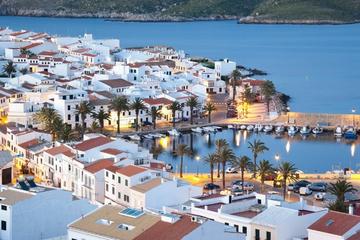
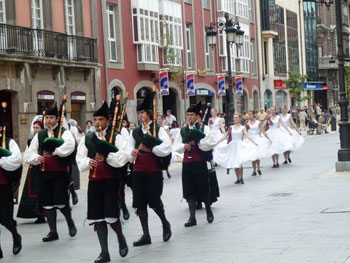
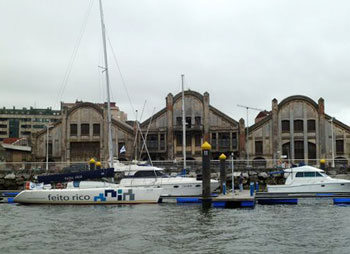 Roman Alvarez Gonzalez is a teacher by profession. We met him during a boat ride along Rio Aviles. Currently he is serving as the Councilor for Culture and Sports in Aviles. Roman’s history 101 lesson includes among other things that Aviles sits on the most northerly tip of Spain and is the third largest city in the Principality of Asturias with 80,000 residents. The natural estuary made it a perfect seaport in the Middle Ages and a key to the salt trade with France, when salt was worth more then gold. Sabugo now a district of Aviles began as a fishing port on the Rio Aviles. In part because of over fishing the fishing industry is no longer a major player in the economy. For a time in the mid 20th century shipbuilding and a steel industry also prospered on the waterfront.
Roman Alvarez Gonzalez is a teacher by profession. We met him during a boat ride along Rio Aviles. Currently he is serving as the Councilor for Culture and Sports in Aviles. Roman’s history 101 lesson includes among other things that Aviles sits on the most northerly tip of Spain and is the third largest city in the Principality of Asturias with 80,000 residents. The natural estuary made it a perfect seaport in the Middle Ages and a key to the salt trade with France, when salt was worth more then gold. Sabugo now a district of Aviles began as a fishing port on the Rio Aviles. In part because of over fishing the fishing industry is no longer a major player in the economy. For a time in the mid 20th century shipbuilding and a steel industry also prospered on the waterfront.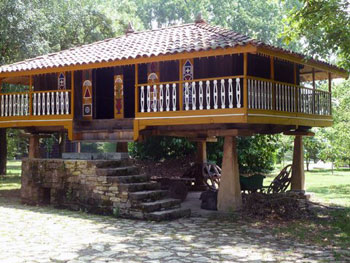 El Café de Joey is in old town Aviles. Joey is Asturian/American and a bit of a history nut. Never reluctant to share his knowledge as he rushes about catering to his customers, Joey tells me over a potato tortilla and cold drink that Aviles was a key to Spain’s exploration for new territory. He points out that the 16th century Spanish explorer Pedro Menedez de Aviles sailed from the walled city to the new world where he founded America’s oldest continually populated city of San Augustin (St. Augustine, Florida). San Augustin is their sister city and their patron saint. While he stops to top up my glass Joey expounds on Asturians in Cuba. Spaniards sailed from Aviles to the Caribbean Island where they were instrumental in developing the island country’s tobacco farming prior to Castro’s regime. El Café de Joey now sits where the medieval cities wall once stood.
El Café de Joey is in old town Aviles. Joey is Asturian/American and a bit of a history nut. Never reluctant to share his knowledge as he rushes about catering to his customers, Joey tells me over a potato tortilla and cold drink that Aviles was a key to Spain’s exploration for new territory. He points out that the 16th century Spanish explorer Pedro Menedez de Aviles sailed from the walled city to the new world where he founded America’s oldest continually populated city of San Augustin (St. Augustine, Florida). San Augustin is their sister city and their patron saint. While he stops to top up my glass Joey expounds on Asturians in Cuba. Spaniards sailed from Aviles to the Caribbean Island where they were instrumental in developing the island country’s tobacco farming prior to Castro’s regime. El Café de Joey now sits where the medieval cities wall once stood.
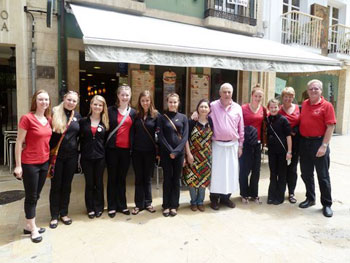 That brings us back to The Beltaine Festival. Celtic music is a big part of Asturian history including bagpipes or gaitas, as they are known in Spain. The Gaiteras are usually accompanied by tamboril (snare drum) and requinta (fife) and folk dancers. The Beltaine Festival attracts Celtic performers from around the Principality of Asturia, Scotland, France, England and this year Juan Carlos took a leap of faith and for the first time invited a Canadian group. From the start of the festival The Inverglen Scottish Dancers performed on the main stage in Parque De La Muelles, in the Plaza De Espana and around the old town to enthusiastic audiences.
That brings us back to The Beltaine Festival. Celtic music is a big part of Asturian history including bagpipes or gaitas, as they are known in Spain. The Gaiteras are usually accompanied by tamboril (snare drum) and requinta (fife) and folk dancers. The Beltaine Festival attracts Celtic performers from around the Principality of Asturia, Scotland, France, England and this year Juan Carlos took a leap of faith and for the first time invited a Canadian group. From the start of the festival The Inverglen Scottish Dancers performed on the main stage in Parque De La Muelles, in the Plaza De Espana and around the old town to enthusiastic audiences.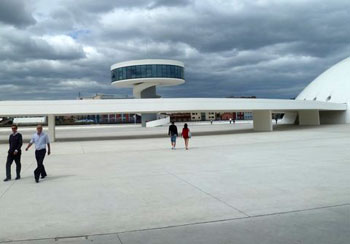 A short train ride away is Gijon, much more touristy then Aviles it is worth a day trip. The Museu del Pueblu d’Asturies preserves the history of the Asturian people and includes a collection of habitats and Horreos from the 17th to 20th century as well as the Asturian Pavilion that was built for the Seville Expo ‘92. It’s well worth a visit. Before catching the train back to Aviles check out the market in Plaza Mayor or just enjoy the sun and sand along Plaza de San Lorenzo.
A short train ride away is Gijon, much more touristy then Aviles it is worth a day trip. The Museu del Pueblu d’Asturies preserves the history of the Asturian people and includes a collection of habitats and Horreos from the 17th to 20th century as well as the Asturian Pavilion that was built for the Seville Expo ‘92. It’s well worth a visit. Before catching the train back to Aviles check out the market in Plaza Mayor or just enjoy the sun and sand along Plaza de San Lorenzo.